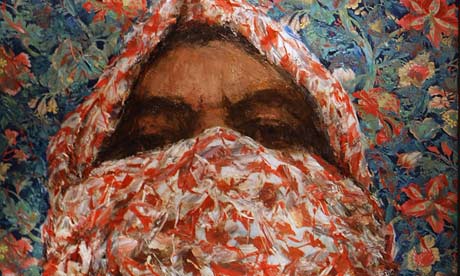In a short time artists born in north Africa and the Middle East have come from nowhere to bask in the limelight, thanks to the Arab spring. This is a good thing, but not exclusively. On the upside, the various upheavals have opened our eyes to the fact that there are creative artists at work on both sides of the Mediterranean. On the downside, there is no relation of cause and effect between the art, which has been there for decades, and recent events. The artists were well ahead of the policymakers, a point underlined by this show, if only because visitors can find out about the artists' background.
We learn that Laila Muraywid, who was born in Damascus in 1956, has been working in Paris since 1981. She combines sculpture, performance and photography with an impressive visual intensity, to address subjects such as women's rights, seduction, desire, secrets and violence. It is astonishing she has only recently come to public notice. Much the same is true of Khaled Takreti, 47, also Syrian and Parisian by adoption. His frantic yet methodical drawing underpins large, chilly paintings, a mixture of anguish and mute silence. Moroccan-born Abderrahim Yamou, 52, paints and crafts objects that prove cruelly ironic once you see past their superficial elegance. Yazid Oulab is a sculptor of about the same age. He specialises in nails, some carved out of wood, others made of glass or inscribed in grey crayon on paper. They are all forms of universal suffering unrelated to particular beliefs.
Some of the exhibitors at the Paris show belong to a younger generation, which is enjoying curiosity without the frustration of having to wait for years to be discovered. Ayman Baalbaki, from Lebanon, is already quite a star, with his hard-hitting portraits of combatants in big brushstrokes of bright colour, in front of pop-art flowering backgrounds and ruined buildings, a souvenir of the wreckage of Beirut. Taysir Batniji, a child of Gaza, has built a black-and-white photographic inventory of the watchtowers and pillboxes surrounding the enclave, in a similar vein to the work of Bernd and Hilla Becher. The pictorial and photographic self-portraits by Hicham Benohoud are more metaphorical. It is hard to know whether to treat these thought-provoking pictures as grotesque or tragic, derisive or self-effacing.
Without indulging in overemphasis, these artists find inspiration in deeply serious situations and issues. This explains why their work often seems more necessary, loaded with much more meaning than a lot of what we see today.
This article originally appeared in Le Monde










